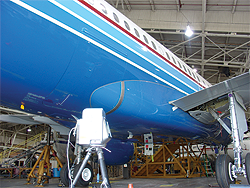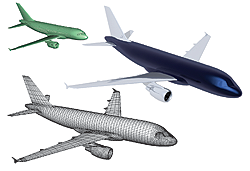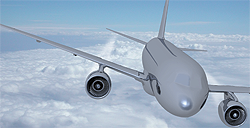SITUATION

Scanning the aircraft
Only recently has modern 3D scanning technologies been able to catch up with the demand for accurate scanning of large physical objects. Digital models of massive aircrafts such as the Airbus A319 can be tested via computational fluid dynamics (CFD) if the model is accurate enough to the actual physical shape. 3D scanning technology is the most effective way to ensure this accuracy. This client, an aerodynamic analysis company, needed surface data of the Airbus A319 to model and test the airworthiness of custom components that would be fit to the aircraft.
CAD data was not available to use for design purposes, therefore the client would need experts in the field of 3D scanning and reverse engineering.
SOLUTION

Scan, Wireframe, CAD
The sheer size of the Airbus A319 made it a unique project in terms of the technical requirements of the scanning equipment. Our team scanned the entire aircraft with the Trimble GS200 – a scanner that excels at capturing large-scale objects and environments. Our engineers used this scan data to register and merge the aircraft into a complete scan model.
Our team performed reverse engineering on the critical features, such as the wings and fuselage, with curvature continuous surfaces by using a combination of Rhinoceros and Rapidform software. These CAD programs ensured a high level of surface control for the reverse engineering process. The CAD data generated from the reverse modeling process could be used downstream for aerodynamic testing and as the base for custom-built parts.
RESULTS

The Airbus A319
The resulting CAD data of the Airbus A319 generated by our reverse engineering process proved to be an invaluable tool for aerodynamic testing. Using this CAD data, the client’s analysis was performed on the jet with the custom-built parts to test how the plane will perform in the air. Impressed with the results, they continue to work with our engineers to perform services on other large model aircraft.
